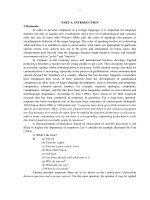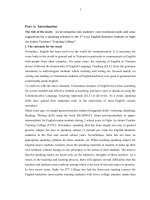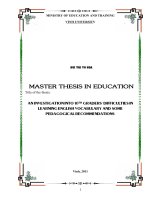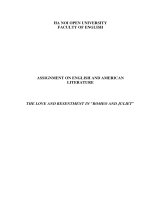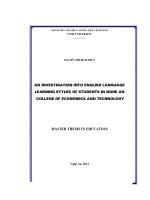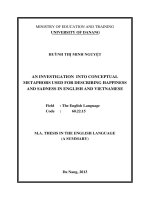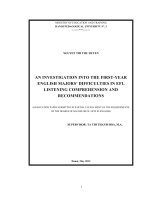An investigation into implicatures in romeo and juliet by william shakespeare
Bạn đang xem bản rút gọn của tài liệu. Xem và tải ngay bản đầy đủ của tài liệu tại đây (477.79 KB, 83 trang )
MINISTRY OF EDUCATION AND TRAINING
UNIVERSITY OF DANANG
LÊ THỊ HẰNG
AN INVESTIGATION INTO IMPLICATURES
IN ROMEO AND JULIET
BY WILLIAM SHAKESPEARE
M.A. THESIS IN THE ENGLISH LANGUAGE
Danang - 2013
MINISTRY OF EDUCATION AND TRAINING
UNIVERSITY OF DANANG
LÊ THỊ HẰNG
AN INVESTIGATION INTO IMPLICATURES
IN ROMEO AND JULIET
BY WILLIAM SHAKESPEARE
Field Study : THE ENGLISH LANGUAGE
Code
: 60.22.15
M.A. THESIS IN THE ENGLISH LANGUAGE
Supervisor: ASSOC. PROF. DR. PHAN VĂN HÒA
Danang - 2013
-i-
STATEMENT OF AUTHORSHIP
Except where reference is made in the thesis, this thesis contains no
material published elsewhere or extracted in whole, or in part from a thesis by
which I have qualified for or been awarded another degree or diploma.
No other person’s work has been used without acknowledgement in the
thesis.
This thesis has not been submitted for award of any degree or diploma
in any other tertiary institution.
Danang, April 2013
LÊ THỊ HẰNG
-ii-
ABSTRACT
This study investigates conversational implicatures in the play Romeo
and Juliet by William Shakespeare by identifying and analyzing utterances
from conversations made by characters in the play. The study was done
within the scope of discourse analysis and pragmatics. Conversational
implicature (CI) was found out in the utterances in conversations made by
characters in the play. Then it was identified and analyzed to find out the
types of CI, the frequency of CI and effect of CI. Grice’s theory of CI is used
as the basic of analysis of the study. The utterances containing implicatures
fall into two categories: generalized and particularized CI.
-iii-
TABLE OF CONTENTS
MINISTRY OF EDUCATION AND TRAINING.......................................1
UNIVERSITY OF DANANG.........................................................................1
MINISTRY OF EDUCATION AND TRAINING.......................................2
UNIVERSITY OF DANANG.........................................................................2
Model Table 1: The Analysis and Classification of Conversational
Implicatures...................................................................................................25
Model table 2: Numbers and Percentages of Conversational Implicatures
.........................................................................................................................25
Model Table 3: Numbers and Percentages of Conversational
Implicatures Are Made by Characters........................................................25
Model Table 4: Effects of Producing Conversational Implicatures.........25
Table 4.1: Types of conversational implicatures........................................29
Table 4.2: Number and percentage on conversational implicatures by
each type.........................................................................................................29
Table 4.3: Effects of producing conversational implicatures....................60
QUYẾT ĐỊNH VỀ VIỆC GIAO ĐỀ TÀI LUẬN VĂN (Bản sao)
-iv-
LIST OF ABBREVIATION
CA
CI
GCI
N
No
PCI
+>
%
:
:
:
:
:
:
:
:
Conversational Analysis
Conversational Implicature
Generalized Conversational Implicature
Number
Cardinal number
Particularized Conversational Implicature
Implicate(s)
Percentage
-v-
LIST OF TABLES
Number
Table 4.1
Table 4.2
Name of tables
Types of conversational implicatures
Number and percentage on conversational
Table 4.3
implicatures by each type
Effects of producing conversational implicatures
Page
28
29
59
-1-
Chapter 1
INTRODUCTION
1.1 RATIONALE
It cannot be denied that language plays a very important role in
communication process. People usually use language to inform, to express
their ideas, and to build up their social relationship. Therefore, language is an
important thing for human beings to maintain their relationship as well as
their life. To communicate effectively the speaker has to use many ways
instead of directly speaking.
Indeed, in daily communication people sometimes say indirectly, they
even “beat about the bush”. In conversation the speech symbols the speaker
utters not only to refer to the subject of his discourse, but also carry with them
quite other overtones of meaning. In some circumstances, a speaker intends to
communicate more than what is said, that something must be more than just
what the words mean. In the literature communication, following the work of
Grice (1967), saying is generally contrasted with implying or implicating.
Every utterance is seen as communicating a variety of proposition, some
explicitly, others implicitly. Saying is seen as falling on the explicit side. In
order to discover what is said by an utterance, the hearer must decode the
sense of the sentence uttered, and then disambiguate any ambiguous
expression, and narrow down the interpretation of any over-vague
expressions, all in the intended way.
Grice introduced the term “implicature” to refer to the intended
implications of an utterance. In implicature one says and communicates one
thing but he or she communicates something else in addition. It is an
-2-
additional meaning, called conversational implicature. To illustrate, the
following is the conversation between Peter and Mary.
Peter: Is John a good cook?
Mary: He’s English
Given the notorious reputation of English cooking, the most natural
interpretation of Mary’s utterance is that she intended to supply the
assumption that the English are bad cook, and to conclude that John is a bad
cook [20, p.18].
Actually, issues related to implicatures in general and conversational
implicatures in particular have been in the focus of linguistic research for
decades and the original theory of conversational implicatures has been
modified and extended by Grice. New theories have also been developed as
possible solutions to problems arising around these linguistic notions.
Although conversational implicatures are one of the central topics in
semantics and pragmatics, it seems that we know much more about them in
theory than in practice. Very little work that has been done looks at
conversational implicatures in spoken language and even less work has been
done on their occurrences in plays.
Lately, it is observed that Vietnamese learners of English, on making
conversations in the target language, often pay little attention to specific
context, have improper or even odd reply to native speakers and then fail in
communicating with others. Recognizing conversational implicatures exactly
and responding felicitously can be regarded as language learners’ pragmatic
competence. Obviously, understanding conversational implicatures plays a very
important role in communication. Especially, understanding conversational
implicatures in plays seems to be a hard work to language learners.
-3-
Therefore, in this study the writer uses play as her source of data. Play is
one of the special tools to explore and express human feelings. It is an essential
form of behaviour in all cultures; it is also a fundamental human activity. Since
the writer is going to do a research on implicatures where the main data is taken
from utterances, play can certainly be her good source of data.
The play which is chosen by the writer is Romeo and Juliet, the famous
Shakespearean play, which has been adapted numerous times for stage, film,
musical and opera. Shakespeare's tragic drama of the “star-crossed” young
lovers Romeo Montague and Juliet Capulet is best remembered for the
famous balcony scene. Romeo Montague and Juliet Capulet are teenagers
who fall deeply in love but their families are bitter enemies. They seize the
moment and marry in secret, they make every effort to conceal their actions
but these end in tragedy when Romeo, Juliet, Tybalt, Mercutio and Paris all
die. The themes running through the play address the issues of the
consequences of immature blind passion, hatred and prejudice [50].
Frankly speaking, when reading Romeo and Juliet, the researcher
noticed that the utterances produced by characters contain a lot of
implicatures, which may make it difficult to understand the play well even if
it has been translated into Vietnamese. Moreover, the language used today is,
in many ways, different to that used in the 16th century Elizabethan era and
this is often reflected in the script used in Shakespearean plays. Therefore, it
is not surprising that we have no experience or no understanding of some of
the words contained in the script of Romeo and Juliet. That is why the writer
was interested in analyzing Romeo and Juliet for her study.
Therefore, it is the effectiveness of the use of implicatures that leads me
to this research: “An Investigation into Implicatures in Romeo and Juliet
by William Shakespeare.”
-4-
I hope my study will be of practical use to the teaching and learning of
English as a foreign language, to the translating of English into Vietnamese
and vice versa, as well as to the comprehension Shakespeare’s works in
general, and Romeo and Juliet in particular.
1.2 AIMS AND OBJECTIVES
1.2.1 Aims
The study aims at helping Vietnamese users of English know how more
implicatures in general and conversational implicatures in particular and
making them more aware of conversational implicatures as an effective tool
of communication so that they can raise their ability to interpret
conversational implicatures.
In addition to understanding conversational implicatures, the writer also
wants Vietnamese users of English to be able to use conversational
implicatures as effective tool in communication. Moreover, through this
study, the writer wants to know which types of implicature that are produced
more frequently by characters in Shakespeare’s work Romeo and Juliet.
1.2.2 Objectives
The study is targeted at
+ Finding out the types of implicatures, why the implicatures are made
+Finding out if producing conversational implicatures can cause
misunderstanding, which may breakdown the conversation
+ Identifying types of implicature in conversations in the play
+Describing, classifying, and analyzing implicatures in terms of
semantics and pragmatics in the play
-5-
1.3 SCOPE OF THE STUDY
This study is done within the scope of discourse analysis and
pragmatics. The researcher analyzes the conversations by all characters in the
play Romeo and Juliet by William Shakespeare. The reasons why the writer
uses all conversations of all characters in the play are because the utterances
they produced contain a lot of implicatures and stretch away to the end of the
play. In addition, this study limits its scope within conversational implicature
that falls into two categories: generalized conversational implicature and
particularized implicature. Then, the implicatures that can be found in this
study are analyzed based on the writer’s interpretation.
The researcher uses Grice’s theory of conversational implicature as the
basic of the analysis of the study.
1.4 RESEARCH QUESTIONS
1. What types of implicatures are identified in the conversations made
by the characters in the play Romeo and Juliet?
2. Which type is produced more frequently in the play?
3. What are the effects of producing implicatures in the play?
1.5 SIGNIFICATION OF THE STUDY
The research of conversational implicatures on the aspects of
pragmatics makes an attempt to contribute to the understanding of language
learners in plays in English. The use of conversational implicatures by
characters in the play Romeo and Juliet analyzed in the study may be of great
benefit for Vietnamese learners of English. I hope it can be a contribution to
improving language competence that benefits not only students, but also
teachers and readers of Shakespeare.
-6-
1.6 ORGANIZATION OF THE STUDY
The research is designed into five chapters as follow:
Chapter 1 Introduction
This chapter covers the rationale, aims and objectives, scope of the
study, research questions, the signification of the study, and the preview of
the organization.
Chapter 2 Review of Literature and Theoretical Background
This chapter reviews the previous studies and the theoretical knowledge
related to this investigation that provides a foundation for the research to rely on.
Chapter 3 Method and Procedures
In this chapter the researcher deals with research approach, data and
source of data, procedure of data collection, sampling, the method of data
analysis and validity and reliability. This chapter also introduces how
conversational implicature is analyzed, how numbers and percentages of data
found in the play Romeo and Juliet are processed. Model tables are also
shown in this chapter.
Chapter 4 Findings and Discussion
This chapter is the key of the paper where the analysis and research
findings of the implicature in Romeo and Juliet by Shakespeare are shown.
The answers to the research questions will be presented in this chapter.
Chapter 5 Conclusions and Implications
This chapter is the summary of the research questions, the procedure
employed and the result obtained. In the end, the implications of the findings
and limitations of the research will be pointed out. This is also the suggestion
for further research on the issues to be investigated in the study.
-7-
Chapter 2
LITERATURE REVIEW
AND THEORETICAL BACKGROUND
This chapter deals with the review of related theories and related
studies. This review is very important because it is used as the basis of the
analysis of the study.
2.1 REVIEW OF RELATED STUDY
Theories of implicatures have been studied, developed, and contributed
much by many linguistic researchers. “Implicature” is an alternative to
“implication” which has additional meanings in logic and informal language,
now frequently used in linguistics as a part of the study of conversational
structure. Implicature is the general term used for two distinct types:
conventional
implicature
and
conversational
implicature.
Actually,
conventional implicature was born into neglect.
The English language philosopher Grice, H. P. (1975) advanced the
term and a definition but only to set such meanings aside. Conversational
implicature, a type of indirect communication, was first described by Grice.
He was more concerned to derive conversational implicatures from the
cooperative principle and the maxims of conversation and acknowledged that
conventional implicatures fell outside the bounds of this pragmatic theory.
Since it was defined by Grice, the notion of conventional implicatures has
raised a lot of debates among linguists.
According to Bach (1999), there are no conventional implicatures, and
the typical examples of conventional implicature triggers noticed by Grice
-8-
actually contribute assertions to the central content of the utterance instead.
[4]
Cruse (2000) used Grice’s theory as a basic to do his research in
implicatures. He takes a closer look at conversational implicatures for
explaining how they arise and be defined.
[7]
Leech (1983) has proposed an independent pragmatic principle to
function alongside the co-operative principle, which he calls the politeness
principle. The greater politeness comes across in the form of implicatures.
The overall mechanism Leech proposes for the generation of implicatures via
the politeness principle is similar to that proposed by Grice for the operative
principle. Like the co-operative principle is intended to be universal, that is,
not cultural dependent, in its application.
[14]
Many Vietnamese linguists who laid the foundation of Vietnamese
pragmatics have raised a plenty of interesting problems related to
conversational implicatures in their researches. This theory was studied and
applied in Vietnamese language by Hoàng Phê (1982,1989), Nguyễn Đức
Dân (1998), Đỗ Thị Kim Kiên (1999, 2005), Nguyễn Thiện Giáp (2008), Mai
Ngọc Chừ, Vũ Đức Nghiệu and Hoàng Trọng Phiến (1997).
According to Đỗ Thị Kim Liên (1999), implicit meaning is the true
meaning of an utterance and can be inferred from a concrete surface structure
in a concrete context.
[30, p219]
In Nguyễn Đức Dân’s opinion (1998), conversational implicature is
devided into two groups:
a. “Hàm ý ngôn ngữ” (which is independent of context)
b. “Hàm ý hội thoại” (which is made in situations of communication)
[25, p.193-194]
-9-
Nguyễn Thiện Giáp (2008) says that in conversation, to understand
what the speaker wants to communicate, the hearer has to know both explicit
meaning drawn from the literal meaning of the words and the structures of the
utterance and implicit meaning inferred from what is said.
[26, p.115]
Cuandy Tukijan (2007) studied conversational implicature found in
Taxi movie, restricted to the utterances spoken by three main characters in the
film. In his study, conversational implicature falls into two categories:
generalized conversational implicature and particularized conversational
implicature.
Locally, conversational implicature has been also studied in some
graduation papers. The similarity of the study of Cuandy Tukijan (2007) and
the study of Võ Thị Thanh Thảo (2011) entitled “A study on conversational
implicatures in Titanic film” is that both of them adopt the theory of
conversational implicature proposed by Grice as a basis of analyzing the data.
This is also the similarity of this study. However, the difference between two
studies is that Cuandy Tukijan investigated conversational implicatures to
find out the types of implicature and which types of implicature that are
produced more frequently while Võ Thị Thanh Thảo investigated
conversational implicatures to find out the reasons for producing implicatures
and the effects of implicatures. Meanwhile, the researcher studies the use of
conversational implicature in a literary work to find out the types of
implicature, which types of implicature that are produced more frequently,
and the effects of implicatures.
In her paper, Nguyễn Thị Hồng Nhạn (2007) made an investigation into
means to signal presupposition and implicatures in English spoken discourse
to identify and analyze the occurrences of presupposed and implicated
information from dialogues and monologues in business and academic
-10-
context. The analysis focused on the lexical, syntactical and pragmatic signals
of presupposition and implicatures.
2.2THEORETICAL BACKGROUND
2.2.1 Definition of Key Terms
To make this study understandable and clear for the readers, the writer
presents definition of key terms related to conversational implicature in the study.
* Utterance is any stretch of talk by one person, before and after which
there is a silence on the part of the person. It is used by a particular speaker on
a particular occasion of a piece of language, such as a sequence of sentences,
or a single phrase, or even a single word.
[5, p.15]
* Conversation is a form of interactive, spontaneous communication
between two or more people who are following rules of etiquette. It is a social
skill that is not difficult for most individuals. Conversations are the ideal form
of communication in some respects, since they allow people with different
views on a topic to learn from each other.
[51]
To have a conversation, two or more people must co-operate, think
about others’ feelings and experiences, and give each other room to talk.
Moreover, conversation is a reciprocal process and a very sophisticated
activity which involves people agreeing about the topic and an immediate
response.
[52]
A conversation is a series of utterances exchanged between two or
more speakers, typically of comparable status, which follows a regular pattern
of turn-taking.
[13, p.208]
* Implicature is used to account for what a speaker can imply, suggest
or mean as distinct from what the speaker literally says [12]. The term
“implicature” is used by Grice (1975) to account for what a speaker can
-11-
imply, suggest, or mean, as distinct from what the speaker literally says [6,
p.31]. The word “implicature” is derived from the verb “to imply”, as is its
cognate “implication”. “To imply” means “to fold” something into something
else (from the Latin verb plicate “to fold”); hence, that which is implied, is
“folded” and has to be “unfolded” in order to be understood.
[15, p.99]
For example, the sentence “Mary had a baby and got married” strongly
suggests that Mary had the baby before the wedding, but the sentence would
still be strictly true if Mary had her baby after she got married. Further, if we
add the qualification "— not necessarily in that order" to the original
sentence, then the implicature is cancelled even though the meaning of the
original sentence is not altered.
In this study, it is very important to distinguish implicature from
presupposition and entailment. A presupposition is something the speaker
assumes to be the case prior to making an utterance. Speakers, not sentences,
have presuppositions. An entailment is something that logically follows from
what is asserted in the utterance. Sentences, not speakers, have entailments.
[22, p.25]
2.2.2 Conversational Analysis
The theory of Conversation Analysis (CA) is issued by Yule (1996), in
which he describes about CA and preference structure. Conversation is
mainly about talking. The term “Conversation Analysis” is to represent any
study of people talking together, “oral communication”, or “language use”.
The structure of the talk, the basic pattern of “I speak – you speak – I speak –
you speak”, will derive from that fundamental kind of interaction people
acquire first and use most often.
[22, p.71]
CA analysts, according to Cutting (2002), say that there is a relation
between acts, and that conversation contains frequently occurring pattern, in
-12-
pairs of utterances known as “adjacency pairs”. They say that the utterance of
one speaker make a certain response of the next speaker very likely. The acts
are ordered with a first part and a second part, and categorized as question –
answer, offer – accept, blame – deny, and so on, with each first part creating
an expectation of a particular second part. This is known as preference
structure: each first part has a preferred and a dispreferred response. The pairs
are endless; here are a few examples.
A question
has the preferred response of
an answer
An offer
an acceptance
An invitation
an acceptance
An assessment
an agreement
A proposal
an agreement
A greeting
a greeting
A complaint
an apology
A blame
a denial
The dispreferred responses tend to be the refusals and disagreements.
These are the more unusual responses, and they can be taken as meaningful or
rude. An absence of response can be taken as the hearer not having heard, not
paying attention, or simply refusing to cooperate.
[10, p.30]
In accordance with Levinson’s opinion, CA has made important
contributions to the understanding of utterance meaning, by showing how a
large proportion of the situated significance of utterance can be traced to their
surrounding sequential environments. Just as the problems of indirect speech
acts can be re-analyzed in CA terms, many of the other central concepts in
pragmatics theory may be amenable to CA treatment. Grice’s theories of
conversational implicature are, of course, prime targets in this regard.
2.2.3 Cooperative Principles
[15]
-13-
Implicatures are primary examples of more being communicated
than is said, but in order for them to be interpreted, some basic
cooperative principles must first be assumed to be in operation.
As phrased by Paul Grice, who introduced it, it states, "Make your
contribution such as it is required, at the stage at which it occurs, by the
accepted purpose or direction of the talk exchange in which you are engaged."
Though phrased as a prescriptive command, the principle is intended as a
description of how people normally behave in conversation.
Listeners and speakers must speak cooperatively and mutually accept
one another to be understood in a particular way. The cooperative principle
describes how effective communication in conversation is achieved in
common social situations.
The cooperative principle can be divided into four maxims, called
the Gricean maxims, describing specific rational principles observed by
people who obey the cooperative principle; these principles enable effective
communication. Grice proposed four conversational maxims that arise from
the pragmatics of natural language. The Gricean Maxims are a way to explain
the link between utterances and what is understood from them.
1. Grice's Maxims: Maxim of Quality: Be Truthful
Do not say what you believe to be false.
Do not say that for which you lack adequate evidence.
2. Maxim of Quantity: Quantity of Information
Make your contribution as informative as is required (for the current
purposes of the exchange).
Do not make your contribution more informative than is required.
3. Maxim of Relevance: Relevance
-14-
Be relevant
With respect to this maxim, Grice writes, “Though the maxim itself is
terse, its formulation conceals a number of problems that exercise me a good
deal: questions about what different kinds and focuses of relevance there may
be, how these shift in the course of a talk exchange, how to allow for the fact
that subjects of conversations are legitimately changed, and so on. I find the
treatment of such questions exceedingly difficult, and I hope to revert to them
in later work.” (Grice 1989)
4. Maxim of Manner: Be Clear
Avoid obscurity of expression
Avoid ambiguity
Be brief (avoid unnecessary prolixity)
Be orderly.
The speaker deliberately flouts a conversational maxim to convey an
additional meaning not expressed literally. For instance, a speaker responds to
the question "How did you like the guest speaker?" with the following
utterance:
Well, I’m sure he was speaking English.
If the speaker is assumed to be following the cooperative principle, in
spite of flouting the Maxim of Quantity, then the utterance must have an
additional nonliteral meaning, such as: “The content of the speaker’s speech
was confusing.”
The speaker’s desire to fulfill two conflicting maxims results in his or
her flouting one maxim to invoke the other. For instance, a speaker responds
to the question “Where is John?” with the following utterance:
He’s either in the cafeteria or in his office.
-15-
In this case, the Maxim of Quantity and the Maxim of Quality are in
conflict. A cooperative speaker does not want to be ambiguous but also does
not want to give false information by giving a specific answer in spite of his
uncertainty. By flouting the Maxim of Quantity, the speaker invokes the
Maxim of Quality, leading to the implicature that the speaker does not have
the evidence to give a specific location where he believes John is.
The speaker invokes a maxim as a basis for interpreting the utterance.
In the following exchange:
- Do you know where I can get some gas?
- There’s a gas station around the corner.
The second speaker invokes the Maxim of Relevance, resulting in the
implicature that “the gas station is open and one can probably get gas there”
2.2.4 Conversational implicatures
There are some circumstances where speakers may not follow the
expectations of the cooperative principle. In courtrooms and classrooms,
witnesses and students are often called upon to tell people things which
are already well-known to those people (thereby violating the quantity
maxim). Such specialized institutional talk is clearly different from
conversation.
However, even in conversation, a speaker may “opt out” of the
maxim expectations by using expressions like “No comment” or “My lips
are sealed” in response to a question. An interesting aspect of such
expressions is that, although they are typically not “as informative as is
required”
in
the
context,
they
are
naturally
interpreted
as
communicating more than is said (i.e. the speaker knows the answer).
This typical reaction (i.e. there must be something “special” here) of
-16-
listeners to any apparent violation of the maxims is actually the key to the
notion of conversational implicature.
[22, p.39]
The basic assumption in conversation is that, unless otherwise
indicated, the participants are adhering to the cooperative principle and
the maxims. In example (1), Dexter may appear to be violating the
requirements of the quantity maxim.
(1) Charlene: I hope you brought the bread and the cheese.
Dexter: Ah, I brought the bread.
After hearing Dexter’s response in (1), Charlene has to assume that
Dexter is cooperating and not totally unaware of the quantity
maxim. But he did not mention the cheese. If he had brought the
cheese, he would say so, because he would be adhering to the
quantity maxim. He must intend that she infer that what is not
mentioned was not brought. In this case, Dexter has conveyed more
than he said via a conversational implicature.
The structure of what is said can be represented, with b (= bread)
and c (= cheese) as in (2). Using symbol +> for an implicature, the
additional conveyed meaning can be also represented.
(2) Charlene: b & c?
Dexter: b
(+> NOT c)
It is important to note that it is speakers who communicate
meaning via implicatures and it is listeners who recognize those
communicated meanings via inference. The inferences selected are
those which will preserve the assumption of cooperation.
[22, p.40]
In short, according to Grice, conversational implicature which is
analyzed in this research must process the following features:
-17-
1. Since, to assume a presence of a conversational implicature, we
have to assume that at least the Cooperative Principle is being
observed, and since it is possible to opt out of the observation of
this principle, it follows that generalized conversational implicature
can be canceled in a particular case. It may be explicitly canceled,
by the addition of a clause that states or implies that the speaker
has opted out, or it may be contextually canceled, if the form of
utterance that usually carries it is used in a context that makes it
clear that the speaker is opting out.
2. Insofar as the calculation that the conversational implicature is
present requires, beside contextual and background information,
only a knowledge of what has been said (or of the conversational
commitment of the utterance), and insofar as the manner of
expression plays no role in calculation, it will not be possible to find
another way of saying the same thing, which simply lacks the
implicature in question, except where some special features of the
substituted version is itself relevant to the determination of an
implicature (in virtue of one of the maxims of Manner). If we call
this
feature
NON-DETACHABILITY,
one
may
expect
a
generalized conversational implicature that is carried by a familiar,
non-special locution to have a high degree of non-detachability.
3. To speak approximately, since the calculation of the presence of a
conversational implicature presupposes an initial knowledge of the
conventional force of the expression the utterance of which carries
the implicature, a conversational implicatum will be a condition
that is not included in the original specification of the expression’s
conventional force. Though it may not be impossible for what starts
-18-
life, so to speak, as a conversational implicature to become
conventionalized, to suppose that this is so in given case would
require special justification. So, initially at least, conversational
implicata are not part of the meaning of the expressions to the
employment of which they attach.
4. Since the truth of a conversational implicatum is not required by
the truth of what is said (what is said may be true – what is
implicated may be false), the implicature is not carried by what is
said, but only by the saying of what is said, or by “putting it that
way”.
5. Since, to calculate a conversational implicature is to calculate what
has to be supposed in order to preserve the supposition that the
Cooperative Principle is being observed, and since there may be
various possible specific explanations, a list of which of may be
open, the conversational implicatum in such cases will be
disjunction of such specific explanations; and if the list of these is
open, the implicatum will have just the kind of indeterminacy that
many actual implicata do in fact seem to possess.
[12, p.57-58]
2.2.5 Classification of Conversational Implicature
According to Grice, conversational implicatures are divided into
two types: generalized conversational implicatures and particularized
conversational implicatures.
a) Generalized conversational implicatures
When no special knowledge is required in the context to calculate
the additional conveyed meaning, it is called a generalized conversational
